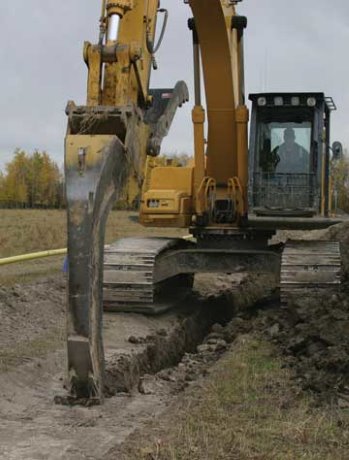Innovations in Alberta pipeline construction are creating a greener way to do business. The new building method disturbs less topsoil by making a trench just slightly wider than the pipe.
Innovations in Alberta pipeline construction are creating a greener way to do business.
“Instead of stripping a right of way 15-18 metres wide, we are stripping one metre and then we commit to getting all the dirt back in the ditch,” said Randy Galbreath, owner of Stratus Pipelines.
His company is the only contractor to use a new building method, which disturbs less topsoil by making a trench just slightly wider than the pipe.
Previously, an excavator would dig a 48 inch trench because that was the size of the bucket.
The same large trench would be used for constructing pipelines as small as three inches in diameter.
Alberta Environment developed Innovative Pipelining Strategies (IPS), which focuses on making the smallest possible environmental impact.
After the pipeline is lowered into place, subsoil is returned to the trench and compacted in layers.
The Kendal Tapered Wheel was developed by Stratus to compact the trench line and return soil during winter construction.
This initial innovation was the inspiration for the IPS process. Other tools such as narrower stripping and excavating buckets, narrow chain and wheel ditchers, and other soil compaction equipment were all developed through the initiative.
There are issues with conventional pipeline construction that lead to sunken trenches and soil loss.
Often sunken ditch-lines aren’t visible to farmers until they hit the depressions with their equipment.
As a result, oil companies were on the hook for expensive repairs to land and equipment, as well as strained relationships with landowners.
Soil quality is another major issue.
“In Northwest Alberta the subsoil is made up of clay,” said Galbreath.
“When we dig a trench it takes a significant effort to put the soil back, because it bulks up to 40 per cent. What we didn’t get back in we were allowed to spread out.”
However, before the soil could be spread out, the government required contractors to strip the top soil.
After the pipeline was lowered, the next step is feathering, where excess ditch spoil or subsoil is spread across the stripped area.
The topsoil is then placed over the feathered subsoil.
Feathering leaves a mound over the ditch line.
In theory, the excess subsoil will eventually settle into the trench, but it often leads to the loss of top soil.
“Over the ditch line there is only two inches of top soil, so as this land is cultivated the clay mixes into the topsoil and the top soil is turned into clay,” explained Galbreath.
“It is not possible to get back.”
Poor quality soil affects crop growth and yield, leading to additional issues with landowners.
In response, Doug Kulba, with Alberta Environment, set out to create a new system for all stakeholders involved in pipeline construction.
“It started a number of years ago, when we realized that in order to achieve different outcomes we needed to think and act differently,” he said.
“The old command and control system based on legislation needed to be changed. You know people want to do the right thing, but the government system was not set up that way.”
According to Galbreath, Devon Energy was the first company to use the new techniques and apply it to a bigger job.
The Canadian Association of Petroleum Producers presented Devon with the 2009 Steward of Excellence Award for its exceptional performance in environmental practices.
The award allows Devon to share this practice with other companies with the objective of the practice becoming a new industry standard.
In May 2008, Devon mandated that contractors use Innovative Pipelining Strategies on all its agricultural pipeline construction in Canada.











Recent Comments
comments for this post are closed